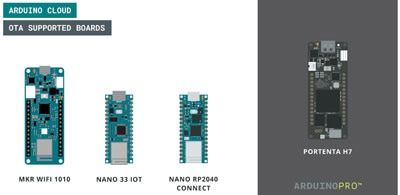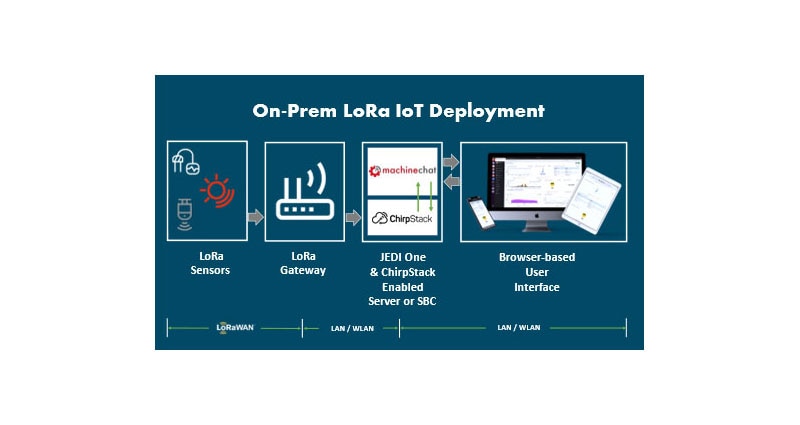Using IoT-Based Technologies to Combat Wildfires
A perfect storm of climate change, human activity, and poor land management has created wildfires of record-breaking size and frequency. In 2021 alone, U.S. wildfires burned more than 10 million acres, thousands of structures, and countless animal habitats. Beyond devastation on the ground, forest fires are responsible for an astonishing 20% of global emissions. Until recently, most focus has been on fighting active blazes. Now, the U.S. Forest Service, research consortiums, and private companies are leveraging the same kind of Internet of Things (IoT) technologies used in factory automation to detect fires at the earliest possible stage.
 Figure 1: The 2021 Caldor Fire as seen through a Teledyne FLIR thermal security camera. (Source: Teledyne FLIR)
Figure 1: The 2021 Caldor Fire as seen through a Teledyne FLIR thermal security camera. (Source: Teledyne FLIR)
Architecture of early fire detection systems
Early wildfire detection relies on real-time situational awareness, often across vast and mountainous landscapes. The structure of these systems is relatively simple (Figure 2). Sensors continuously collect air quality and weather data. When a preset threshold is reached, that data goes to the cloud where artificial intelligence (AI) and machine learning algorithms are applied. Alerts are instantaneously relayed to a base station where fire watchers use a network of infrared cameras to confirm the situation.
 Figure 2: Forest fire detection using IoT-based sensors, network gateways, and the cloud. (Source: PsiBorg.com)
Figure 2: Forest fire detection using IoT-based sensors, network gateways, and the cloud. (Source: PsiBorg.com)
Companies including Bosch Sensortec, Ericsson, and Acti have developed components able to withstand extreme conditions. Silvanet, Dryad’s ultra-early detection system, is an end-to-end solution that integrates solar-powered sensors, a proprietary Long Range Wide Area Network (LoRaWAN)-based mesh networking infrastructure, and a cloud analytics platform.
Wireless sensor networks
Wireless sensor networks (WSNs) are reliable, low cost, and easy to scale, making them well-suited for fire detection applications. Nodes are deployed strategically throughout a wilderness area on everything from portable masts to tree trunks to utility poles. Device detection ranges from tens of meters up to 15 km.
Silvanet Wildfire Sensors (Figure 3) are designed to detect fire within 1 to 60 minutes. The inbuilt Bosch BME688 sensor detects hydrogen, carbon monoxide, and other gases at the parts per million (ppm) level. The BME688 is the first gas sensor with AI and integrated high-linearity and high-accuracy pressure, humidity, and temperature sensors.
 Figure 3: The Bosch BME688 gas sensor built into the Silvanet’s solar-powered wildfire sensor. (Source: Bosch Sensortec)
Figure 3: The Bosch BME688 gas sensor built into the Silvanet’s solar-powered wildfire sensor. (Source: Bosch Sensortec)
Mesh IoT networks
Mesh IoT networks sidestep the infrastructure challenges of cellular networks by directly connecting each node to every other node in a decentralized manner. Signals hop between nodes to reach destinations that aren’t within an individual sensor’s range. Data is transmitted to a cloud server via networks such as LoRaWAN, which has exceptional distance capability combined with low power consumption … making it suitable for wide-range IoT applications.
Infrared thermography
High-definition PTZ (pan/tilt/zoom) infrared cameras use thermal imaging to detect heat signatures and temperature variations. Personnel at base stations have direct command and control of the cameras, allowing them to monitor the landscape, fire behavior, and weather in real time. With a full 360° pan, 90° tilt, and 40X optical zoom, AEM’s Wildfire PTZ camera creates a 3D map of environmental conditions in a radius of 25 miles. Wildfire management teams use the company’s FTS360 software platform to view live imagery with weather data overlay.
 Figure 4: AEM’s Wildfire PTZ camera. (Source: AEM)
Figure 4: AEM’s Wildfire PTZ camera. (Source: AEM)
Early fire detection research
A 2023 partnership between the Department of Homeland Security and the Oregon Hazard Lab (OHAZ) will evaluate sensing technologies against the alerts generated by the ALERTWildfire camera system. ALERTWildfire’s HD cameras have near-infrared capabilities ranging from up to 40 miles during the day and 60 to 80 miles at night. It’s a high-bandwidth system so anyone with internet connectivity can access its public video feeds. The sensing devices were developed by Breeze Technologies of Hamburg, Germany, and N Sensors of Rockville, Md. The research is taking place in Oregon’s Willamette Valley.
 Figure 5: Sensors designed by Breeze Technologies (left) and N5 Sensors (right) installed in the Willamette Valley, Oregon. (Source: Breeze Technologies and N5 Sensors)
Figure 5: Sensors designed by Breeze Technologies (left) and N5 Sensors (right) installed in the Willamette Valley, Oregon. (Source: Breeze Technologies and N5 Sensors)
Real-time information helps fire managers make resource allocation and public safety decisions. Consistent data allows fire scientists to identify patterns based on environmental variables. In spite of such promising developments, the fact is more than 80% of forest fires are caused by human carelessness such as unattended campfires, tossed cigarettes, debris burning, and equipment malfunctions. On September 5, 2020, a pyrotechnic device set off at a gender-reveal baby shower ignited California's deadly El Dorado Fire. The fire burned more than 22,000 acres and resulted in the death of a firefighter. The couple responsible for the party were charged with 30 crimes and involuntary manslaughter. Maybe as states begin to hold individuals legally responsible for irresponsible behavior like this, there will be fewer fires to detect.
Sources
Dampage, U., et al. (2022). Forest fire detection system using wireless sensor networks and machine learning. Sci Rep 12, 46.
Gupta, V. (2023, February 1). Forest Fire Protection Using Sensor Network and IoT. PsiBorg.
Peruzzi, G., & Pozzebon, A. (2023). Fight Fire with Fire: Detecting Forest Fires with Embedded Machine Learning Models Dealing with Audio and Images on Low Power IoT Devices. Sensors, 23(2), 783.
Stoking Wildfire Resilience in Oregon | Homeland Security. (2023, February 9).
Wildfire Causes and Evaluations (US National Park Service). (n.d.)

Have questions or comments? Continue the conversation on TechForum, DigiKey's online community and technical resource.
Visit TechForum












